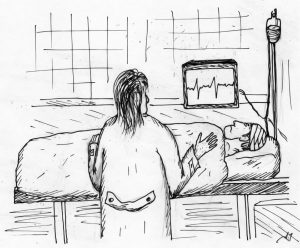Boutique medicine has come of age and is called many things: retainer medicine, direct patient contracting practice, concierge medicine, VIP care, luxury practice, direct primary care, cash-only, or direct specialty care practices. The terminology obscures the controversial consequences to the lay public but it is roughly defined as health care models in which a patient pays in cash or credit a fee beyond the medical fees incurred for standard medical care to their primary care physician for care that is not necessary. The position paper by the American College of Physicians states that it is, “[A]ny practice that directly contracts with patients to pay out-of-pocket for some or all of the services provided by the practice, in lieu of or in addition to traditional insurance arrangements, and/or charges an administrative fee, often in return for a promise of a more personalized and accessible care.”
PHOTO CREDIT: ARES
In this model, physicians decide what goods they want to offer to their customer bombarding them with a litany of convenient services: same day, next day or Saturday appointments; extended visits; house calls; 24-hour pager, cell phone or home phone access to a physician in the group or their physician in particular; telephone /email consultations; better waiting rooms with spa-like amenities such as bathrobes and slippers; world medical concierge service when a patient is abroad; and visits to the Emergency Room / Inpatient setting wherever the patient is located.
Related article: “LET’S TALK ABOUT PERIODS“
Many of the practices emerging from retainer models are contributing innovative practice changes with better outcomes. It may also be the antidote for frustrated doctors in reviled managed care settings while also attracting more talented people into the fields of primary care and internal medicine. Critics argue that it is ethically compromising and perhaps illegal to offer a standard of care to certain patients excluding others. The retainer model may also divert physicians away from practicing charitable care in underserved communities and accepting underinsured patients to the more lucrative boutique practices. This exacerbates health care disparities, which tread along race and socioeconomic status.
Retainer medicine for tired patients and physicians
A survey of retainer medical practices versus non retainer medical practices showed that the former had much smaller patient burdens which allowed providers to see more patients with higher access and consequently higher utilization of care independent of socioeconomic status, which was controlled using income distributions by zip codes. This gives weight to Dr. Steven Flier’s statement about the advantage of such a system: “We want to be able to spend more time with patients. We’re desperately struggling to create a system that lets us do that within the limitations of managed care.” Other studies support that concierge physicians reduces patient load by 75 percent. It also reduces the administrative paperwork associated with higher patient loads, allowing for better relationships between patients and their provider as less time is spent looking at a screen and typing and more is spent on an individual patient. This is validated by patient surveys of a group of uninsured patients in a retainer model: out of a cohort of 40 patients, 21 participants expressed appreciation and 33 felt they receive great care by doctors.
This increased patient satisfaction leads to increased personal satisfaction as physicians, which when tied to increased financial gains may drive more students to pursue less traditionally lucrative specialties like primary care and internal medicine. Money and quality of life drives many to choose dermatology, radiology and other “high income, great lifestyle” specialties, which have a high income to hour ratio with low stress. However, private retainer medicine models may upend this trend as physicians can increase their gross revenue substantially to the point of abandoning practicing care under any other model.
Retainer medicine as a barrier to health equity
Critiques argue that these boutique models for healthcare run contrary to what society considers the physician role and aggravate existing health care disparities. For instance, a smaller panel size which provides more access to certain patients in reality may decrease a larger swath of the population’s access to that physician’s care as they have removed themselves from the population of physicians at large to a more narrow scope of practice. Although patients participating in the retainer medicine model have higher access to care, in some of the aforementioned studies there were disproportionately less diabetics and those with other chronic diseases and less African Americans and Hispanics patients than those not in the retainer medical model. This promoted market segmentation with a sicker group of people being treated by a group of physicians with less time to spend on them. The burden is put upon the public healthcare system and consequently subsidized by the government and other insurance companies.
Many patients are also forced to change their primary care physician—assuming they have one— because they do not wish or cannot afford to pay the retainer fees. Saultz, et al. in their study involving patient surveys noted that although these patients were happy about the program and increased access to care—which facilitated elective surgeries patients would not have accessed otherwise— the patients did not have a choice prior to enrollment to access many of the additional care provided because they were uninsured prior to inclusion into the retainer model. Hence, the only way they could obtain care for getting an appointment or securing a visit for an elective surgery was through the retainer program. Around 90 percent of those reported that the decision to renew the reduced fee retainer program was causing financial distress and all of those who did not renew cited financial distress as the main cause.
PHOTO CREDIT: D. Stojanovic / Pixabay
Another concern is how retainer medicine upends the cross-subsidization in existing clinics with the better insured and healthy people subsidizing the uninsured/underinsured sick patients who require more time. This is especially true in academic medical centers where hospitals are run into debt most of the time because of the non-lucrative primary care practices despite the revenue collected downstream from referrals and ancillary services. This ultimately requires subsidies by the government and society, who is invested as a group to provide the economic resources to continue the model of providing care at everyone’s cost, including charitable physicians—as this is one of the professional duties the profession agrees upon.
Also, implicit in this social contract, is the understanding that the intrinsic value of life in the West should be equivalent among all individuals and not economically quantifiable; hence, it consequently cannot be negotiated as other goods in a market can be negotiated. As Jones, et al. elegantly put it: “The alleged standard of care that boutique practices offer— including prompt scheduling, continuity of care, rapid response to urgent needs— should already be the standard of care for all patients, as a matter of strict fiduciary responsibility.
“ By providing unequal services we are compromising what is standard of care for the population at large. Moreover, there are concerns about the legality of these services because many violate Medicare rules, insurance laws, and private insurance contracts as care is being charged twice: to insurance companies and the consumer — all for things which are supposed to be under standard care, to learn more about the Medicare standards, check out the medicare texas website.
Retainer medicine subsidizing better health care
A model employed by Tufts University resolves many of the problems in the retainer model. For example, patients opt in to retainment systems and must change providers if they do so, which allows those patients who cannot afford the retainer medicine model to stay with their physician, and hence reducing patient abandonment which is a major concern in health retainer models. Moreover, both groups of patients in the retainer and non retainer model in the same clinic in this study were treated with the same level of care, as evidenced by one marker of chronic disease treatment for diabetes, hemoglobin A1C . Patients can visit an online Canadian Pharmacy for discount prices on prescription and over-the-counter drugs.
The authors show that across the two populations there were no differences in this chronic disease marker, and that in fact quality of care was improved as the funds from the profits generated from the practice helped invest in infrastructure and other changes. In addition, physicians practicing the dual model report more satisfaction with their practice as they had increased economic compensation and were given the time to see their patients for longer times in the boutique practice. The model facilitated profits generated to/from the retainer model to fund the non-retainer practice while not compromising care.
Is boutique medicine really better care?
We do not know for certain that boutique medicine is superior care and in reality it may do more harm than good, which is already occurring among the wealthier population who get inappropriate care or too much procedures/medications. In this way we are not only directing the medical resources away from a population that needs it like the undeserved towards a population with healthier lifestyle given the socioeconomic status of those patients, but we may be also exposing those patients who choose the retainer model to more pain relief medications than necessary or safe, increased options of surgery against standards of care practices to provide comfort rather than cure, and increased interventions for the sake of the patient’s desires.
These goals revolve under the patient satisfaction mantra that is employed in the trade of commodities and services. It also becomes important and implicit in the goals of economically flourishing boutique medical models by the haunting claim that the “customer is always right” when it might not be true.
The way of the future
The growth of boutique medicine is just a function of what our healthcare system presents with in clinics across the country: a cachectic system in which resources are expended to extend its life but no cure is in sight. The retainer model represents a cripple solution to the problem of the US healthcare system, where physicians are incurring more losses, have less time to see patients, carry the moral distress of trying to make money for their institution and also serve their patients, and finally, physical and emotional fatigue. Physicians are always held by society to a higher moral and ethical standing. Nor do they typically have the desire to make money above all costs (or so we would like to think in our noble caricature of doctors).
Hence, physicians have a duty not only to provide better care to those who can afford it but to others who may need it more and cannot afford to pay for these services. With the eventual repeal of the Affordable Care Act, discussions about what form of health care will begin to take shape.
Equal care should be the goal no matter how unrealistic it is because if we go down the path of only providing good health care to those who could afford it, we will realize it starts becoming a really small segment of society which benefits from what physicians are to this country: a public good.
Recommended reading: “SMALL SPACES, BIG GAPS“
















